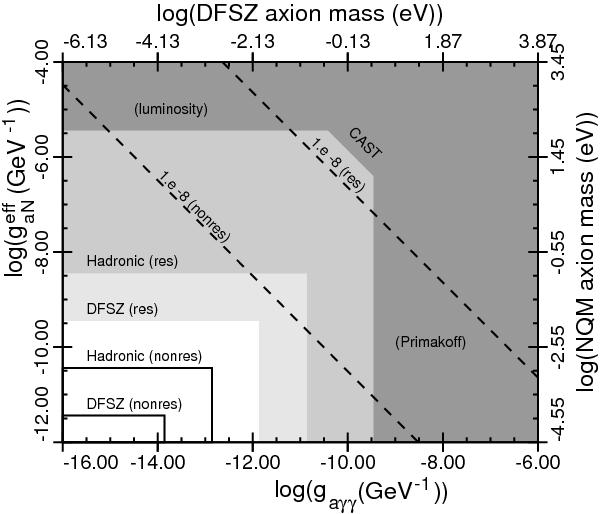Fig. 4

The  parameter space. The dark region at the top and right indicates the region ruled out by CAST (Andriamonje et al. 2009). The horizontal portion labeled (luminosity) comes from a constraint on the total Fe57 axion luminosity as a fraction of the solar luminosity, and the vertical section labeled (Primakoff) comes from CAST constraints on axions produced by the Primakoff process, both from Andriamonje et al. (2009). The dashed contour below this indicates the where this limit moves with the nondetection of a count rate of 10-5 s-1 by NUSTAR (a flux of 10-8 photons cm-2 s-1) for resonant axion-photon mode conversion. The shaded contours indicate the “forbidden” mass regions (>10-2 eV) towards the upper right for DFSZ or hadronic axions corresponding to the values of gaγγ and
parameter space. The dark region at the top and right indicates the region ruled out by CAST (Andriamonje et al. 2009). The horizontal portion labeled (luminosity) comes from a constraint on the total Fe57 axion luminosity as a fraction of the solar luminosity, and the vertical section labeled (Primakoff) comes from CAST constraints on axions produced by the Primakoff process, both from Andriamonje et al. (2009). The dashed contour below this indicates the where this limit moves with the nondetection of a count rate of 10-5 s-1 by NUSTAR (a flux of 10-8 photons cm-2 s-1) for resonant axion-photon mode conversion. The shaded contours indicate the “forbidden” mass regions (>10-2 eV) towards the upper right for DFSZ or hadronic axions corresponding to the values of gaγγ and  (assuming the naive quark model). The lower dashed contour indicates the limit achieved by the same NUSTAR count rate for nonresonant axion-photon mode conversion in the outer layers of the solar atmosphere. The rectangular boxes indicate the “allowed” mass limits (<10-4 eV) for this case. These “forbidden” or “allowed” mass regions do not apply in the case of massless arions; only the CAST limits apply. Clearly, substantial parameters space is available to solar observations detecting nonresonant mode conversion of arions.
(assuming the naive quark model). The lower dashed contour indicates the limit achieved by the same NUSTAR count rate for nonresonant axion-photon mode conversion in the outer layers of the solar atmosphere. The rectangular boxes indicate the “allowed” mass limits (<10-4 eV) for this case. These “forbidden” or “allowed” mass regions do not apply in the case of massless arions; only the CAST limits apply. Clearly, substantial parameters space is available to solar observations detecting nonresonant mode conversion of arions.
Current usage metrics show cumulative count of Article Views (full-text article views including HTML views, PDF and ePub downloads, according to the available data) and Abstracts Views on Vision4Press platform.
Data correspond to usage on the plateform after 2015. The current usage metrics is available 48-96 hours after online publication and is updated daily on week days.
Initial download of the metrics may take a while.


